LOS ANGELES — This fall, Getty’s sweeping PST Art: Art & Science Collide initiative will take place at museums and galleries across Southern California. Officially kicking off September 15 and running through February 16, 2025, exhibitions at over 70 cultural institutions and four dozen galleries will explore the intersection of aesthetics and technology with a wide focus, from the historical to the contemporary, the scholarly to the speculative, the astronomical to the fantastical.
Getty’s PST Art initiative, originally called Pacific Standard Time, debuted in 2011 with Art in LA 1945–1980, followed by LA/LA in 2017, which traced connections between the city and Latin American and Latine artists. (A much smaller version in 2013 focused on modern architecture in LA.) These earlier projects were more clearly connected to Los Angeles than the upcoming series, which ranges from historical exhibitions on color in Mesocamerican art and the Medieval study of light to solo presentations of work by Olafur Eliasson and The Harrisons, reflections on 20th century collaborative antecedents such as Experiments in Art and Technology and Arteonica, and group shows dealing with government surveillance and invisibility as a form of resistance.
However, with scientific hubs like the California Institute of Technology and NASA’s Jet Propulsion Laboratory (both of which are hosting PST shows) in close proximity to vibrant artistic ecosystems and schools, the Southland ultimately seems like a fitting home for this year’s sprawling thematic umbrella.
“Southern California has a distinctive, perpetually innovative art scene,” Getty Foundation Director Joan Weinstein told Hyperallergic. “And it also has one of the most important scientific communities in the world.”
Beyond the high-tech collaborations that have been a crucial part of LA’s art world since the mid-20th century, the area’s physical terrain — lush, polluted, contested, endangered — is a common throughline.
“For some of the artists in our exhibitions, the landscape of the Los Angeles region itself serves as a combination of studio and laboratory for everything from exploring the complex sites where freshwater and ocean waters mix to restoring soil contaminated by industrial waste,” Weinstein said.
Beatriz da Costa’s PigeonBlog (2006–8) was an interdisciplinary grassroots research project that aimed to gather and distribute climate data to the public. It is highlighted in Los Angeles Contemporary Exhibitions’s exhibition Beatriz da Costa: (un)disciplinary tactics at the Los Angeles Municipal Art Gallery, which restages several of the late artist’s democratizing hybrid artworks that empower citizen-scientists, free from corporate entanglements.
“We wanted to activate the work, rather than present it as an obsolete thing,” curator Daniela Lieja Quintanar told Hyperallergic. To that end, the show will feature two pigeon releases at Crenshaw Dairy Mart on October 19 and at Barnsdall Art Park on November 16, involving the same pigeon fancier that da Costa collaborated with.
Indigenous knowledge is another anchor in several exhibitions of the PST Art program, and one that has a deep relevance in Southern California. Sangre de Nopal at the Fowler Museum, a collaboration between textile artists Tanya Aguiñiga and Porfirio Gutiérrez, traces the origins of cochineal, a red dye developed by Zapotec scientists from an insect that lives on cacti. “Los Angeles is home to the largest Oaxacan community outside of Mexico, and we are also home to the borderless cochineal, which thrives on the opuntia cactus all over the American West,” Aguiñiga told Hyperallergic.


Although farming the cochineal insect involves scientific expertise across several fields including agriculture, biology, and chemistry, Gutiérrez stressed that Western and Indigenous forms of scientific thought are often at odds.
“There is no separation between art and science in the Indigenous world,” he said. “When it comes to these materials, art and science are always in communion … Color doesn’t start in the artist’s studio, it starts in nature. If you don’t understand those processes, you’ll have a difficult time transforming material into color.”
In a different vein, World Without End: The George Washington Carver Project at the California African American Museum is a reappraisal of the life, career, and legacy of this pioneering artist and scientist. Best known for his influential research into the versatility of peanuts, Carver began his career as a landscape painter, earning the nickname “the Black Leonardo” for his dual commitment to art and science. Alongside his own artwork and experiments, the exhibition features contemporary artists engaging with his legacy, including Sam Shoemaker, whose mycological sculptures reverberate with Carver’s own work on mushrooms; Abigail DeVille, who reinterprets Carver’s “Jesup wagon,” a mobile classroom through which he would spread agricultural education to sharecroppers; and Henry Taylor and Karon Davis, who collaborated on an installation depicting Carver at his easel.

While some of the PST exhibitions highlight “collisions” of art and science, as the thematic title suggests, for many others the boundaries are harder to discern, representing intertwined threads of unified creative strategies, as Gutiérrez noted. Channing Hansen’s fiber works are featured in a solo presentation at Marc Selwyn Fine Arts and in Energy Fields: Vibrations of The Pacific Rim organized by Fulcrum Arts and presented at Chapman University, a group show centering artists working with sound, vibration and kinetics. Hansen blends the analog and digital, twisting wool into yarn before dying it and using computer algorithms based on natural phenomena to create patterns.
Hansen told Hyperallergic that he does not think of art and science as “distinct realms that can be fused or not.”
“Some people might explain my work by saying science provides a kind of conceptual foundation, but that misses the fact that science is in every aspect of its making as well,” he said. “For example, in the genetic material I use for my wool, in my approach to color using spectrometry, in the algorithms that dictate the patterns created by the process of knitting, and in the topographies of the manifolds that I knit. It requires no effort to incorporate science — it just is science.”




